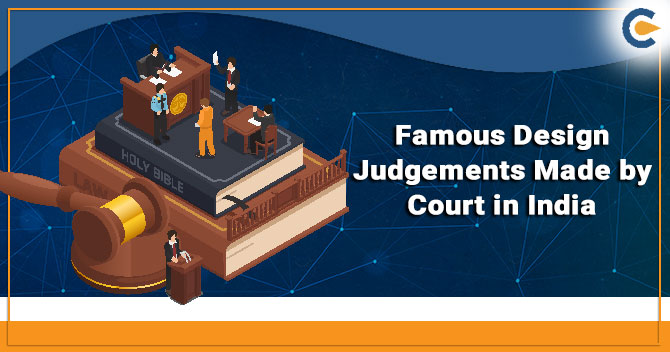In our everyday life, we all come across various designs which help us recognise a product, and these designs are not limited to a particular subject matter. These designs are used in many areas and in different forms, such as drawings or creating blue prints of an industrial setup or interior designing. In the last two decades, we all have seen a rapid growth and development in intellectual property rights to the point that they now play a crucial role in a country’s economy and its development. These different forms of IP work (Copyright for the protection of artistic and literary, Trademarks for the protection of words or symbols, Patents for the protection of inventions, Designs of for the protection of a shape, any configuration, patterns, ornament or composition of lines or colours, Geographical Indications, Semiconductor integrated circuit layouts and Plant varieties) are protected under the umbrella of IPR also called as Intellectual Property Law. IP law provides protection on the basis of, ‘First to file, First to get the registration and benefits.’ Prior to the Act of 2000, designs were governed by the Design Act of 1911. To bring the design act to par with international standards and international law, the Design Act of 2000 was enacted by the central government. Under the act, it is mandatory for the proprietor to register their design so that they can protect their original work from being copied by a third party. Also, a registered design increase the commercial value and popularity of the product in the global market. This article will guide your way through major laws that govern the registered design in India.
An Overview to Design Act Of 2000
Definitions
The term ‘design’ has been defined under Section 2 sub-clause d. According to the act, design means “Features of shape, pattern, configuration, ornament or composition of colours or lines which is applied in three dimensional or two dimensional or in both the forms using any of the processes whether manual, chemical, mechanical, separate or combined, and are judged solely by the eyes. It should neither include any mode of construction nor any trademark as defined under clause (v) of sub-section (1) of the section 2 of the Trade & Merchandise Marks Act of 1958. It should not include a property mark as defined under the Section 479 of the Indian Penal Code or any artistic work as defined under clause (c) of the Section 2 of the Copyright Act of 1957.”
In simple terms design includes the aesthetics and the overall display of the product.
Important Sections of the Act
Some important sections under the act which are essential to know are as follows:
CHAPTER 2 – REGISTRATION OF DESIGNS
- Section 3 of the act talks about the controller and other officers.
- Section 4 of the act talks about the prohibition of registration of certain designs.
- Section 5 of the act talks about the application for registration of designs.
- Section 6 of the act talks about the registration to be in respect of a particular article.
- Section 7 of the act talks about the publication of particulars of registered designs.
- Section 9 of the act talks about the certificate of registration.
- Section 10 of the act talks about the register of designs.
CHAPTER 3 – COPYRIGHT IN REGISTERED DESIGNS
- Section 17 of the act talks about the inspection of registered designs.
- Section 19 of the act talks about the cancellation of registration
CHAPTER 5 – LEGAL PROCEEDINGS
- Section 22 of the act talks about the piracy of registered design.
- Section 31 of the act talks about the rectification of the register.
CHAPTER 7 – POWERS & DUTIES OF CONTROLLER
- Section 32 of the act talks about the powers of Controller in proceedings under Act.
Essentials of a Registered Design
If you are looking forward to registering a design in India, you must have the following characterises in your design:
- Novelty and originality;
- Design must be unique;
- A prior publication is not acceptable; also, the design should be purely distinguishable from other designs;
- The design must be applied to a particular article only;
- The design needs to be visible on the finished product;
- The design must not be in contrary with order and morality;
- It must not relate to any obscenity or to such materials which are inappropriate (as mentioned under Section 35 of the act);
- The designs need to be as per Locarno classification (it is an agreement by which the designs are registered under the Act. It helps to divide designs into different classes. These classifications are mainly function-oriented).
Things That Can’t Be Registered As a Design under the Act
The act provides the list of things which cannot be registered in India, these are as follows:
- Signs, seals or banners of any nation;
- Size of any article, whenever changed;
- Structures and buildings;
- Incorporated circuits’ format designs;
- Trade Variation;
- Any guideline or method of development of any article, for example, marks, tokens, kid’s shows, cards, and so forth;
- Books, schedules, certificates, coats, structures and different archives, welcoming cards, maps and plan cards, postcards, flyers, stamps, medals, and dressmaking designs.
- A mechanical contraption;
- Workshop modifications of segments of a get-together;
- Portions of any article which isn’t produced and sold independently.
Origin of the Act
The origin of the Design Act can be traced back to the British period. The first ever act related to design was the Patent and Designs Act of 1872. The Act of 1872 supplemented the act passed by the Governor-General of India in 1859. Both the acts protected industrial designs and grant privileges to inventors.
But in 1888, the Patent and Designs Act of 1872 was repealed, and the government enacted a new act called the Inventions and Designs Act of 1888. The Act of 1888 was a reflection of the Designs Act of the United Kingdom. In 1911, the British government enacted new laws, by bringing the provisions of patent and design under one act. Then in 1970, the patent Act was passed by both the houses to only deal with the provisions related to patents.
In the year 1995, India became a signatory member of the WTO, also known as World Trade Organisation and the Act of 1911 was repealed, and a new act was enacted by the government, called the Designs Act of 2000. The Act of 2000 is in compliance with TRIPS, also called as the Agreement on Trade-Related Aspects of Intellectual Property Rights.
Design Protection under the Paris Convention
The Paris Convention for the protection of industrial property was adopted on March 20, 1883. India is a signatory member of the convention, and therefore the provision of the right of priority is applicable on India. This means if the proprietor files an application for registration in India or in any one of the signatory states. The applicant can file the same application in all the signatory countries, within a period of six months from the date of filling out the first application. The later application will be treated as if it was filed on the same day as the first one.
Benefits of a Registered Design
The following are the benefits available to a registered design:
- It provides the ability to license-out;
- Helps in maintaining fair market competition;
- It gives the ability to sue;
- It enhanced the commercial value of the product;
- Gives good return on investment;
- Helps in legal protection against piracy;
- Helps in Product differentiation.
Duration of a Registered Design in India
A registered design in India is valid for ten years from the registration date. If the proprietor wants, then ten-year period can be extended to five years. For this, the inventor has to file Form-3 along with the required fee and submit it to the controller before the expiry of the said initial period.
Note: In the case where the claim to priority has been allowed ten years will be counted from the priority date.
Infringement of a Registered Design
Section 22 of the Design Act of 2000, talks about the infringement of registered designs also can be called as piracy of a registered design. The act says, if a person has fraudulently copied a registered design without the inventor’s person, then he has committed the offence of piracy under Section 22.
In case of the infringement, the proprietor of the registered design has two remedies under Section 22(2)(a) and Section 22(2)(b) of the Designs Act of 2000.
Cancellation of the Registered Design
As per Section 19 the Design act of 2000, the Controller can cancel to register a design one of the following grounds:
- If the design has already been registered under the act;
- If it has been published in India or any other country before the date of registration;
- If the design is not registerable under this Act of 2000;
- If the design is not an original or unique;
- If the design is not as per definition under clause (d) of section 2 of the act.
Conclusion
The concept of design has become a part of our daily life. We all come across various designs that help us recognise a product in our everyday life. Coming up with a product design that is original and the novel takes a lot of effort and hard work. An eye-appealing design will always help the proprietor to gain commercial value and customer recognition. But there are many people out there to seek benefits out of goodwill by copying your design. Therefore it is advisable always to register your designs under the Design Act of 2000[1]. The registration will help you to sue and get compensation for the act of infringement.
Looking at the current provisions of the Designs Act of 2000, the government has outdone itself compared to previous laws. The act is much more precise and focused on acting as an umbrella for the protection of registered designs at large and aiding the promotion of competitiveness in a market economy.
Read Our Article: Design Registration And Protection In India











